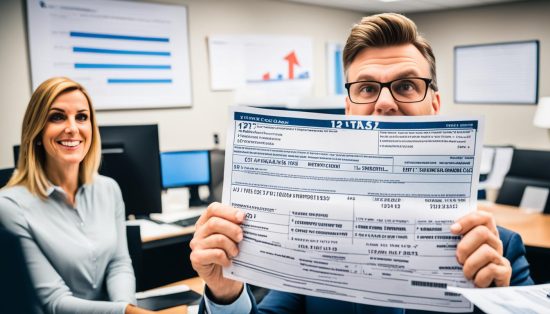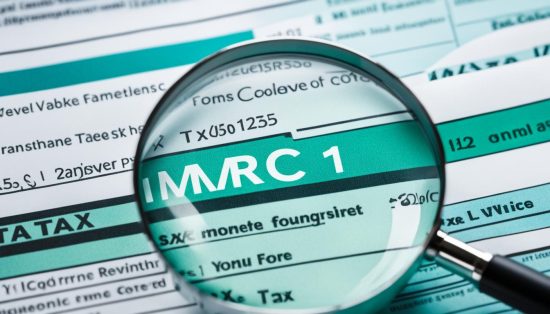Last Updated on: 16th April 2024, 06:27 am
A tax code is a string of numbers and letters that tells your employer how your earnings should be taxed. In the UK, one of the commonly used tax codes is 1257L W1. The code “1257L” signifies that it is a regular tax code for individuals with one job and no untaxed income, unpaid tax, or taxable benefits. The “W1” component indicates that the tax code is an emergency tax code used when a new employee does not have a P45. The W1 tax code is temporary and non-cumulative, meaning it does not consider any tax already paid in the tax year. It is specifically designed for individuals who are paid on a weekly basis.
What is the Tax Code 1257l W1 in UK?
Tax Code 1257L W1 has important implications for individuals in the UK. It determines the amount of tax that will be deducted from their pay throughout the year. Understanding the breakdown of the tax code is crucial. The numbers in the tax code represent the individual’s tax-free allowance, while the letter provides additional information about the tax calculation. In the case of tax code 1257L W1, the tax-free allowance is £12,570 for the tax year, and the letter “L” indicates that the individual is entitled to the standard tax allowances.
The Breakdown of Tax Code 1257L W1
To better understand how tax code 1257L W1 affects your income, let’s break it down:
| Component | Meaning |
|---|---|
| 1257 | Tax-free allowance amount |
| L | Standard tax allowances |
| W1 | Emergency tax code for new employees without a P45 |
The tax-free allowance of £12,570 is the amount you can earn before you start paying income tax. It represents the portion of your income that is not subject to taxation. The letter “L” indicates that you are entitled to the standard tax allowances, ensuring that you receive the appropriate deductions and allowances based on your circumstances.
It is important to note that the tax code may change based on changes in personal circumstances or new employment. Therefore, it’s crucial to regularly review your tax code and ensure its accuracy by consulting with HM Revenue and Customs (HMRC).
Eligibility for Tax Code 1257l W1
Tax code 1257L W1 is designed for individuals who meet specific eligibility criteria. To be eligible for this tax code, the following conditions must be met:
- The individual must have one job and no additional sources of untaxed income.
- There should be no unpaid tax or taxable benefits, such as a company car, that affect the tax calculation.
Additional Considerations
It is important to understand that tax codes are tailored to individual circumstances and may vary based on factors like additional income sources or specific tax reliefs. Therefore, determining eligibility for tax code 1257L W1 requires a thorough review of employment and financial situations in consultation with HM Revenue and Customs (HMRC).
1. Tax Allowance
A tax allowance is the amount of income an individual can earn before they start paying income tax. For tax code 1257L W1, the tax-free allowance is £12,570 for the tax year. This means that individuals eligible for this tax code can earn up to £12,570 without being subject to income tax.
To summarize, tax code 1257L W1 is applicable to individuals with one job and no untaxed income, unpaid tax, or taxable benefits. It is essential to review personal circumstances and consult with HMRC to determine eligibility and make sure the tax code accurately reflects the individual’s situation.

Calculation of Tax Code 1257l W1
The calculation of tax code 1257L W1 is based on the individual’s tax-free allowance and tax brackets. The tax-free allowance represents the amount of income an individual can earn before they start paying income tax. For tax code 1257L W1, the tax-free allowance is £12,570. Income above this threshold is subject to income tax at the applicable tax rate. The tax rate varies based on the individual’s income level and falls into different tax brackets.
Understanding the tax brackets is essential for determining the amount of tax an individual will pay. Tax brackets refer to different income ranges, each with a corresponding tax rate. The tax code 1257L W1 applies to individuals earning within a specific range of income, and their tax liability increases as their income moves into a higher tax bracket.
Tax Brackets for Tax Code 1257l W1
| Income Range | Tax Rate |
|---|---|
| Up to £12,570 | 0% |
| £12,571 to £50,270 | 20% |
| Above £50,270 | 40% |
As illustrated in the table above, individuals with tax code 1257L W1 are not required to pay income tax on the first £12,570 of their earnings. From £12,571 up to £50,270, the tax rate is 20%. Any income above £50,270 is subject to the higher tax rate of 40%. It is important to note that these tax brackets may change periodically, reflecting updates to the UK tax system.
It is crucial for individuals with tax code 1257L W1 to accurately calculate their tax liability based on their income and tax brackets. This ensures compliance with tax regulations and prevents under- or overpayment of taxes. It is advisable to consult with a tax professional or utilize online tax calculators to accurately determine the tax amount owed.
Advantages of Having Tax Code 1257l W1
Holding tax code 1257L W1 provides individuals with significant advantages. Firstly, it ensures they receive appropriate tax allowances, effectively reducing the amount of tax deducted from their earnings. As a result, individuals can retain more of their hard-earned income.
Furthermore, individuals who possess this tax code may be eligible for tax refunds in the event of overpaying taxes throughout the year. This presents an opportunity to reclaim excess payments and bolster financial stability.
To fully capitalize on these benefits, it is crucial for individuals to regularly assess their tax code accuracy. Reviewing their circumstances and ensuring their tax code reflects their current situation allows them to take full advantage of the opportunities presented by the tax code 1257L W1.

The Benefits of Tax Code 1257L W1 at a Glance
- Reduced tax deduction from earnings, maximizing take-home pay.
- Potential eligibility for tax refunds.
- Financial stability enhanced by optimizing tax allowances.
- Opportunity to actively manage tax liabilities.
By leveraging the advantages offered by tax code 1257L W1, individuals can enjoy increased financial autonomy and better control over their tax obligations.
| Tax Code 1257L W1 Advantages | Description |
|---|---|
| Reduced Tax Deduction | The tax code ensures a decreased amount of tax deducted from individuals’ earnings, allowing them to keep more of their income for personal use. |
| Tax Refund Eligibility | If individuals overpay taxes throughout the year, they have the opportunity to reclaim excess payments, providing them with a financial boost. |
| Optimized Tax Allowances | Reviewing and ensuring the accuracy of tax codes enables individuals to optimize tax allowances, maximizing their financial stability. |
| Proactive Tax Liability Management | Holding tax code 1257L W1 empowers individuals to actively manage their tax liabilities and make informed financial decisions. |
Common Misconceptions About Tax Code 1257l W1
When it comes to tax code 1257L W1, there are a few common misconceptions that individuals should be aware of.
Misconception 1: Tax Code Remains the Same Throughout the Tax Year
One common misconception is that the tax code remains unchanged throughout the entire tax year. However, this is not the case. Tax codes can be subject to changes based on personal circumstances or changes in employment.
For example, if an individual takes on a second job or their income significantly increases, their tax code may need to be adjusted to reflect their new tax obligations. It is important to regularly review your tax code to ensure that it accurately reflects your current situation.
Misconception 2: Tax Code Determines the Total Amount of Tax Paid for the Year
Another common misconception is that the tax code determines the total amount of tax an individual will pay for the entire tax year. While the tax code does play a role in calculating the amount of tax deducted from each paycheck, it does not determine the final tax liability.
The total amount of tax an individual pays is based on their total income, including any additional sources of income, as well as factors such as tax reliefs and allowances. These variables can impact the final tax liability, even with the same tax code.
Therefore, it is important to understand that tax codes are just one part of the overall tax calculation and should not be solely relied upon to determine your total tax obligation.

By dispelling these common misconceptions, individuals can gain a better understanding of how tax code 1257L W1 works and ensure that they accurately assess their tax liability. It is always recommended to seek professional advice or consult with HM Revenue and Customs (HMRC) for personalized guidance on tax matters.
How to Check Your Tax Code and Make Changes if Necessary?
Regularly checking your tax code is crucial to ensure its accuracy and avoid any potential discrepancies. The easiest way to check your tax code is by accessing your personal tax account on the HM Revenue and Customs (HMRC) website. By logging in to your account, you can view your tax code and any updates or changes that have been made.
If you believe that your tax code is incorrect or needs to be updated, it is essential to contact HMRC. You can do this by reaching out to their customer service and providing them with the necessary information. Make sure to include details about your employment, income, and any changes in personal circumstances that may affect your tax code.
HMRC will review the provided information and make the necessary adjustments to your tax code. It is important to keep in mind that HMRC’s response time may vary, so it is advisable to contact them as soon as you notice any issues with your tax code.

Steps to Check and Update Your Tax Code
- Visit the HMRC website and log in to your personal tax account.
- Navigate to the section that displays your tax details.
- Locate your tax code and review it carefully.
- If you notice any discrepancies or believe your tax code needs updating, contact HMRC.
- Provide HMRC with the necessary information, such as employment details and changes in personal circumstances.
- Wait for HMRC to review your case and make the necessary adjustments to your tax code.
- Regularly check your personal tax account for updates and changes to your tax code.
By proactively checking your tax code and promptly making any necessary changes, you can ensure that your tax affairs are in order. This will help you avoid potential under or overpayment of taxes and ensure that you are accurately taxed based on your current circumstances.
Conclusion
In conclusion, understanding tax code 1257L W1 is crucial for individuals in the UK to accurately assess their tax liability. This tax code determines the amount of tax deducted from an individual’s pay throughout the tax year. By comprehending the tax implications, eligibility criteria, and calculation of tax code 1257L W1, individuals can make informed decisions about their finances.
Regularly checking the accuracy of your tax code is essential to ensure you are taking advantage of available tax allowances. This can help minimize the amount of tax deducted from your pay and potentially lead to tax refunds if you have overpaid during the year.
Keep in mind that tax codes can change throughout the tax year based on personal circumstances or new employment. Stay informed about any updates or changes in tax codes and consult HM Revenue and Customs (HMRC) for personalized guidance on tax matters. Taking proactive steps to understand and manage your tax code will ensure you are making the most of your tax allowance and staying compliant with UK tax regulations.




















No Comments
Leave a comment Cancel